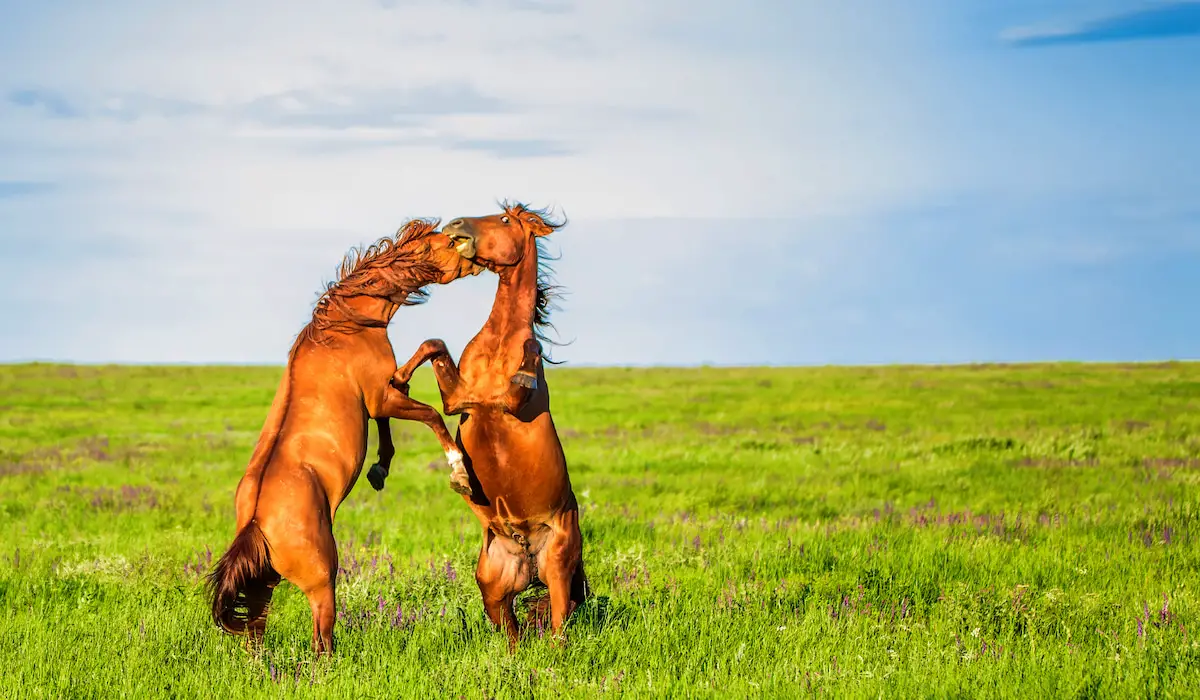Horses are magnificent creatures known for their strength, grace, and beauty. They have been domesticated for thousands of years and have played a crucial role in human history. As prey animals, horses have developed various mechanisms to protect themselves from potential threats in the wild. Understanding how horses protect themselves can provide valuable insights into their behavior and needs. In this article, we will explore the different ways in which horses protect themselves and how these behaviors have evolved over time.
Understanding the Herd Mentality

One of the most important ways in which horses protect themselves is through their strong herd mentality. In the wild, horses live in social groups known as herds, which provide them with safety in numbers. By staying together, horses can alert each other to potential dangers and coordinate their responses to threats. This herd mentality is ingrained in their instincts and plays a crucial role in their ability to protect themselves.
Communication and Vigilance
Within a herd, horses communicate with each other through various vocalizations, body language, and visual cues. They are highly vigilant animals, constantly scanning their surroundings for any signs of danger. When one horse detects a potential threat, it can alert the rest of the herd, prompting them to flee or take defensive actions. This collective awareness and communication within the herd are essential for their survival in the wild.
Strength in Numbers
Horses understand the concept of safety in numbers. By sticking together, they can dissuade predators from attacking, as the combined strength and solidarity of the herd can be a formidable deterrent. Predators are less likely to target a group of horses compared to a solitary individual, making the herd a crucial form of protection for these animals.
Physical Defense Mechanisms

In addition to their herd mentality, horses have also developed physical defense mechanisms to protect themselves from potential threats. These mechanisms are a result of their evolutionary adaptations and play a crucial role in their survival.
Kicking
One of the most well-known defense mechanisms of horses is their powerful kicking ability. Horses have strong hind legs equipped with powerful muscles, allowing them to deliver swift and forceful kicks to fend off predators or aggressive individuals. This behavior serves as a warning and a means of defense, helping horses to ward off threats and protect themselves and their herd members.
Biting and Striking
Horses also have the ability to bite and strike with their front legs when confronted with a threat. While they generally prefer to flee from danger, they can resort to aggressive behaviors as a last resort. Their sharp teeth and strong hooves can inflict serious injuries, making them formidable opponents when threatened.
Flight Response
One of the most common defense mechanisms of horses is their instinctive flight response. When faced with a perceived threat, horses are known to flee at high speeds, utilizing their exceptional running ability to escape from danger. Their speed and agility allow them to outrun many predators, making flight a crucial survival strategy for horses in the wild.
Adaptations for Survival
Over the course of evolution, horses have developed various adaptations that enable them to protect themselves and thrive in their natural environments. These adaptations have contributed to their success as a species and continue to shape their behavior and physiology.
Camouflage
Horses have evolved to have natural camouflage, allowing them to blend in with their surroundings and remain inconspicuous to potential predators. Their coat colors and patterns can help them to avoid detection and reduce the risk of being targeted by predators. This adaptation is particularly important for wild horses living in open and exposed environments.
Keen Senses
Horses possess keen senses, including exceptional hearing and a keen sense of smell, which enable them to detect potential threats from a distance. Their acute senses allow them to remain vigilant and respond quickly to any signs of danger, giving them an advantage in protecting themselves and their herd.
Instinctive Behaviors
Many of the ways in which horses protect themselves are rooted in instinctive behaviors that have been honed through generations of natural selection. These behaviors include vigilance, alertness, and the ability to assess and respond to potential threats swiftly and effectively. These instinctive behaviors are crucial for the survival of wild horses and continue to influence the behavior of domesticated horses.
Human Impact on Horses
While horses have developed effective ways to protect themselves in their natural environments, human activity has had a significant impact on their ability to thrive and defend themselves. The domestication of horses, habitat loss, and human encroachment have posed new challenges for these animals, altering their natural behaviors and survival strategies.
Domestication and Training
The domestication of horses has led to significant changes in their behavior and social structure. Domesticated horses often lack the same level of freedom and opportunity to exhibit natural defense mechanisms, as their interactions with humans have reshaped their responses to threats. Training and handling practices also play a role in shaping the behavior of domesticated horses, influencing their ability to protect themselves in various situations.
Habitat Loss and Fragmentation
Human activities such as urbanization, agriculture, and infrastructure development have resulted in the loss and fragmentation of natural habitats for wild horses. This has reduced their access to suitable living environments and increased their exposure to human disturbances and potential threats. As a result, wild horse populations face greater challenges in protecting themselves and maintaining their natural behaviors.
Conservation Efforts and Advocacy
In response to the growing threats facing wild and domesticated horses, conservation efforts and advocacy initiatives have emerged to protect and preserve these magnificent animals. These efforts aim to restore and conserve natural habitats, raise awareness about the importance of horses in ecosystems, and promote sustainable management practices to ensure the well-being and protection of horses.
Interested in learning more about horses and their behaviors? Check out our articles on how horses reproduce, why horses weave, and how wild horses maintain their hooves for fascinating insights into the world of these majestic animals!
Conclusion
Horses have evolved a range of defense mechanisms and survival strategies that enable them to protect themselves from potential threats in their natural environments. Their herd mentality, physical defense mechanisms, and evolutionary adaptations all play a crucial role in their ability to thrive and survive. Understanding how horses protect themselves not only provides valuable insights into their behavior but also underscores the importance of conservation and responsible stewardship to ensure the well-being and protection of these remarkable animals. Whether in the wild or in human care, horses continue to captivate us with their resilience, strength, and innate ability to protect themselves.



